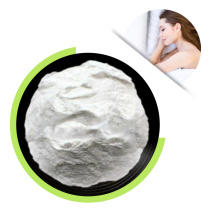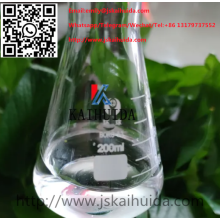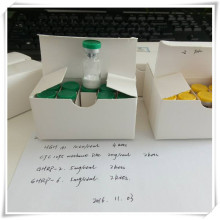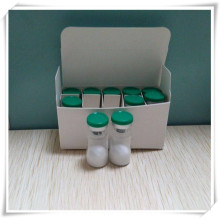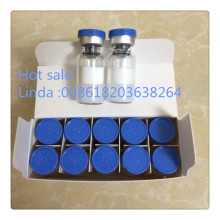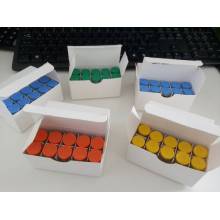Best Sale Amino Acids Oxytocin Acetate Pharmaceutical Peptide Lab Supply
Basic Info
Model No.: 50-56-6
Product Description
Model NO.: 50-56-6 Customized: Customized Suitable for: Adult Purity: >98% Form: Powder Packing: Vial Other Name: Oxytocin Shelf Life: 2 Years Specification: 10 mg/vial Powder: Yes Certification: GMP State: Solid Name: Oxytocin Acetate Color: White Appearance: White Powder Type: API Trademark: Filter Origin: Shanghai Product Name : Oxytocin Acetate
Oxytocin Acetate Description :
Oxytocin is a mammalian hormone that acts primarily as a neuromodulator in the brain. Oxytocin is best known for its roles in sexual reproduction, in particular during and after childbirth. It is released in large amounts after distension of the cervix and uterus during labor, facilitating birth, and after stimulation of the nipples, facilitating breastfeeding. The word oxytocin was derived from the Greek word", meaning quick birth. The oxytocin peptide is synthesized as an inactive precursor protein from the OXT gene.
Oxytocin is a peptide of nine Amino Acids (a nonapeptide). Its systematic name is cysteine-tyrosine-isoleucine-glutamine-asparagine-cysteine-proline-leucine-glycine-amine (cys, tyr, ile,gln,asn,cys, pro, leu, gly - NH2, or CYIQNCPLG-NH2). The cysteine residues form a disulfide bond. Oxytocin has a molecular mass of 1007 daltons. One international unit (IU) of oxytocin is the equivalent of about 2 micrograms of pure peptide. The trust-inducing property of oxytocin might help those who suffer from social anxieties and mood disorders, but with the potential for abuse with confidence tricks and military applications.
The structure of oxytocin is very similar to that of vasopressin (cys,tyr,phe, gln,asn,cys, pro,arg,gly - NH2), also a nonapeptide with a sulfur bridge, whose sequence differs from oxytocin by two amino acids. A table showing the sequences of members of the vasopressin/oxytocin super family and the species expressing them is present in the vasopressin article. Oxytocin and vasopressin were isolated and synthesized by Vincent du Vigneaud in 1953, work for which he received the Nobel Prize in Chemistry in 1955.
Oxytocin and vasopressin are the only known hormones released by the human posterior pituitary gland to act at a distance. However, oxytocin neurons make other peptides, including corticotropin-releasing hormone and dynorphin, for example, that act locally. Oxytocin has peripheral (hormonal) actions, and also has actions in the brain. Its actions are mediated by specific, high-affinity oxytocin receptors. The oxytocin receptor is a G-protein-coupled receptor that requires Mg2+ and cholesterol.
Does Oxytocin Play a Role in Autism?
Oxytocin may play a role in autism and may be an effective treatment for autism's repetitive and affiliative behaviors. Oxytocin treatments also resulted in an increased retention of affective speech in adults with autism. Two related studies in adults, in 2003 and 2007, found oxytocin decreased repetitive behaviors and improved interpretation of emotions. More recently, intranasal administration of oxytocin was found to increase emotion recognition in children as young as 12 who are diagnosed with autism spectrum disorders.
Oxytocin and the Gastro Tract:
Oxytocin is destroyed in the gastrointestinal tract, so must be administered by injection or as nasal spray. It has a half-life of typically about three minutes in the blood, and given intravenously does not enter the brain in significant quantities - it is excluded from the brain by the blood-brain barrier. Evidence in rhesus macaques indicates oxytocin by nasal spray does enter the brain. Oxytocin nasal sprays have been used to stimulate breastfeeding, but the efficacy of this approach is doubtful.
Neural Sources of Oxytocin:
In the hypothalamus, oxytocin is made in magnocellular neurosecretory cells of the supraoptic and paraventricular nuclei, and is stored in Herring bodies at the axon terminals in the posterior pituitary. Oxytocin is also made by some neurons in the paraventricular nucleus that project to other parts of the brain and to the spinal cord.[73] Depending on the species, oxytocin receptor-expressing cells are located in other areas, including the amygdala and bed nucleus of the stria terminalis. In the pituitary gland, oxytocin is packaged in large, dense-core vesicles, where it is bound to neurophysin I. Secretion of oxytocin from the neurosecretory nerve endings is regulated by the electrical activity of the oxytocin cells in the hypothalamus.
Non-neural sources of Oxytocin:
Outside the brain, oxytocin-containing cells have been identified in several diverse tissues, including the corpus luteum, the interstitial cells of Leydig, the retina, the adrenal medulla, the placenta, the thymus and the pancreas. The finding of significant amounts of this classically "neurohypophysial" hormone outside the central nervous system raises many questions regarding its possible importance in these different tissues. The Leydig cells in some species have also been shown to possess the biosynthetic machinery to manufacture testicular oxytocin de novo, to be specific, in rats (which can synthesize vitamin C endogenously), and in guinea pigs, which, like humans, require an exogenous source of vitamin C (ascorbate).
Recent Research Related to Oxytocin and Effects:
Research has shown that Oxytocin evokes feelings of contentment, reductions in anxiety, and feelings of calmness and security around the mate. Many studies have already shown a correlation of Oxytocin with human bonding, increases in trust, and decreases in fear. One study confirmed a positive correlation between Oxytocin plasma levels and an anxiety scale measuring the adult romantic attachment. This suggests Oxytocin may be important for the inhibition of the brain regions associated with behavioral control, fear, and anxiety, thus allowing orgasm to occur.
Romantic attachment:
In some studies, high levels of plasma oxytocin have been correlated with romantic attachment. For example, if a couple is separated for a long period of time, anxiety can increase due to the lack of physical affection. Oxytocin may aid romantically attached couples by decreasing their feelings of anxiety when they are separated. A study reported increases of oxytocin during sexual arousal could be in response to nipple/areola, genital, and/or genital tract stimulation as confirmed in other mammals. Research found oxytocin levels were raised throughout sexual arousal with no acute increase at orgasm. A more recent study of men found an increase in plasma oxytocin immediately after orgasm, but only in a portion of their sample that did not reach statistical significance. The authors noted these changes "may simply reflect contractile properties on reproductive tissue".
Maternal behavior:
Female rats given oxytocin antagonists after giving birth do not exhibit typical maternal behavior. By contrast, virgin female sheep show maternal behavior toward foreign lambs upon cerebrospinal fluid infusion of oxytocin, which they would not do otherwise. Oxytocin is involved in the initiation of maternal behavior, not its maintenance; for example, it is higher in mothers after they interact with unfamiliar children rather than their own.
Sexual arousal:
Oxytocin injected into the cerebrospinal fluid causes spontaneous erections in rats, reflecting actions in the hypothalamus and spinal cord. Centrally administrated oxytocin receptor antagonists can prevent noncontact erections, which is a measure of sexual arousal. Studies using oxytocin antagonists in female rats provide data that oxytocin increases lordosis behavior, indicating an increase in sexual receptivity.
Hot Sale pharmaceutical peptide for your reference :
Why Chose US :
1 Professional Team
2 Best quality and best purity
3 Golden Forwarder
4 Sincerely Service
5.warehouse in UK ,Germany and France .
If you have any interest ,please contact with Krystal .
Phone: +86-157-37953140
Contact us if you need more details on Oxytocin Acetate Pharmacetical Peptide. We are ready to answer your questions on packaging, logistics, certification or any other aspects about Oxytocin Acetatepharmaceutical Intermediate、Oxytocin Acetate CAS: 50-56-6. If these products fail to match your need, please contact us and we would like to provide relevant information.
Oxytocin Acetate Description :
Oxytocin is a mammalian hormone that acts primarily as a neuromodulator in the brain. Oxytocin is best known for its roles in sexual reproduction, in particular during and after childbirth. It is released in large amounts after distension of the cervix and uterus during labor, facilitating birth, and after stimulation of the nipples, facilitating breastfeeding. The word oxytocin was derived from the Greek word", meaning quick birth. The oxytocin peptide is synthesized as an inactive precursor protein from the OXT gene.
Oxytocin is a peptide of nine Amino Acids (a nonapeptide). Its systematic name is cysteine-tyrosine-isoleucine-glutamine-asparagine-cysteine-proline-leucine-glycine-amine (cys, tyr, ile,gln,asn,cys, pro, leu, gly - NH2, or CYIQNCPLG-NH2). The cysteine residues form a disulfide bond. Oxytocin has a molecular mass of 1007 daltons. One international unit (IU) of oxytocin is the equivalent of about 2 micrograms of pure peptide. The trust-inducing property of oxytocin might help those who suffer from social anxieties and mood disorders, but with the potential for abuse with confidence tricks and military applications.
The structure of oxytocin is very similar to that of vasopressin (cys,tyr,phe, gln,asn,cys, pro,arg,gly - NH2), also a nonapeptide with a sulfur bridge, whose sequence differs from oxytocin by two amino acids. A table showing the sequences of members of the vasopressin/oxytocin super family and the species expressing them is present in the vasopressin article. Oxytocin and vasopressin were isolated and synthesized by Vincent du Vigneaud in 1953, work for which he received the Nobel Prize in Chemistry in 1955.
Oxytocin and vasopressin are the only known hormones released by the human posterior pituitary gland to act at a distance. However, oxytocin neurons make other peptides, including corticotropin-releasing hormone and dynorphin, for example, that act locally. Oxytocin has peripheral (hormonal) actions, and also has actions in the brain. Its actions are mediated by specific, high-affinity oxytocin receptors. The oxytocin receptor is a G-protein-coupled receptor that requires Mg2+ and cholesterol.
Does Oxytocin Play a Role in Autism?
Oxytocin may play a role in autism and may be an effective treatment for autism's repetitive and affiliative behaviors. Oxytocin treatments also resulted in an increased retention of affective speech in adults with autism. Two related studies in adults, in 2003 and 2007, found oxytocin decreased repetitive behaviors and improved interpretation of emotions. More recently, intranasal administration of oxytocin was found to increase emotion recognition in children as young as 12 who are diagnosed with autism spectrum disorders.
Oxytocin and the Gastro Tract:
Oxytocin is destroyed in the gastrointestinal tract, so must be administered by injection or as nasal spray. It has a half-life of typically about three minutes in the blood, and given intravenously does not enter the brain in significant quantities - it is excluded from the brain by the blood-brain barrier. Evidence in rhesus macaques indicates oxytocin by nasal spray does enter the brain. Oxytocin nasal sprays have been used to stimulate breastfeeding, but the efficacy of this approach is doubtful.
Neural Sources of Oxytocin:
In the hypothalamus, oxytocin is made in magnocellular neurosecretory cells of the supraoptic and paraventricular nuclei, and is stored in Herring bodies at the axon terminals in the posterior pituitary. Oxytocin is also made by some neurons in the paraventricular nucleus that project to other parts of the brain and to the spinal cord.[73] Depending on the species, oxytocin receptor-expressing cells are located in other areas, including the amygdala and bed nucleus of the stria terminalis. In the pituitary gland, oxytocin is packaged in large, dense-core vesicles, where it is bound to neurophysin I. Secretion of oxytocin from the neurosecretory nerve endings is regulated by the electrical activity of the oxytocin cells in the hypothalamus.
Non-neural sources of Oxytocin:
Outside the brain, oxytocin-containing cells have been identified in several diverse tissues, including the corpus luteum, the interstitial cells of Leydig, the retina, the adrenal medulla, the placenta, the thymus and the pancreas. The finding of significant amounts of this classically "neurohypophysial" hormone outside the central nervous system raises many questions regarding its possible importance in these different tissues. The Leydig cells in some species have also been shown to possess the biosynthetic machinery to manufacture testicular oxytocin de novo, to be specific, in rats (which can synthesize vitamin C endogenously), and in guinea pigs, which, like humans, require an exogenous source of vitamin C (ascorbate).
Recent Research Related to Oxytocin and Effects:
Research has shown that Oxytocin evokes feelings of contentment, reductions in anxiety, and feelings of calmness and security around the mate. Many studies have already shown a correlation of Oxytocin with human bonding, increases in trust, and decreases in fear. One study confirmed a positive correlation between Oxytocin plasma levels and an anxiety scale measuring the adult romantic attachment. This suggests Oxytocin may be important for the inhibition of the brain regions associated with behavioral control, fear, and anxiety, thus allowing orgasm to occur.
Romantic attachment:
In some studies, high levels of plasma oxytocin have been correlated with romantic attachment. For example, if a couple is separated for a long period of time, anxiety can increase due to the lack of physical affection. Oxytocin may aid romantically attached couples by decreasing their feelings of anxiety when they are separated. A study reported increases of oxytocin during sexual arousal could be in response to nipple/areola, genital, and/or genital tract stimulation as confirmed in other mammals. Research found oxytocin levels were raised throughout sexual arousal with no acute increase at orgasm. A more recent study of men found an increase in plasma oxytocin immediately after orgasm, but only in a portion of their sample that did not reach statistical significance. The authors noted these changes "may simply reflect contractile properties on reproductive tissue".
Maternal behavior:
Female rats given oxytocin antagonists after giving birth do not exhibit typical maternal behavior. By contrast, virgin female sheep show maternal behavior toward foreign lambs upon cerebrospinal fluid infusion of oxytocin, which they would not do otherwise. Oxytocin is involved in the initiation of maternal behavior, not its maintenance; for example, it is higher in mothers after they interact with unfamiliar children rather than their own.
Sexual arousal:
Oxytocin injected into the cerebrospinal fluid causes spontaneous erections in rats, reflecting actions in the hypothalamus and spinal cord. Centrally administrated oxytocin receptor antagonists can prevent noncontact erections, which is a measure of sexual arousal. Studies using oxytocin antagonists in female rats provide data that oxytocin increases lordosis behavior, indicating an increase in sexual receptivity.
Hot Sale pharmaceutical peptide for your reference :
| Specification | |
| ≥95% | 10iu/vial |
| ≥95% | 10iu/vial |
| ≥95% | 10iu/vial |
| ≥95% | 10iu/vial |
| GHRP-2 | 5mg/vial |
| GHRP-6 | 5mg/vial |
| CJC-1295 without DAC(CJC-1293) | |
| ≥98% | 2mg/vial |
| ≥98% | 2mg/vial |
| CJC-1295 (DAC) | |
| ≥95% | 2mg/vial |
| Sermorelin Acetat | |
| >95% | 2mg/vial |
| IGF-1LR3 | |
| ≥98% | 0.1mg/vial |
| ≥98% | 1mg/vial |
| ≥98% | 0.1mg/vial |
| PT-141 | 10mg/vial |
| Hexarelin | 2mg/vial |
| MT-II (Melanotan II ) | |
| ≥98.8% | 10mg/vial |
| MGF (IGF-1Ec) | 2 mg/vial |
| Ipamorealin | |
| ≥98% | 2mg/vial |
| TB-500 | |
| ≥95% | 5mg/vial |
| ≥95% | 10mg/vial |
| Oxytocin Acetate | 2mg/vial |
| ≥98%&99% | 5mg/vial |
Why Chose US :
1 Professional Team
2 Best quality and best purity
3 Golden Forwarder
4 Sincerely Service
5.warehouse in UK ,Germany and France .
If you have any interest ,please contact with Krystal .
Phone: +86-157-37953140
Contact us if you need more details on Oxytocin Acetate Pharmacetical Peptide. We are ready to answer your questions on packaging, logistics, certification or any other aspects about Oxytocin Acetatepharmaceutical Intermediate、Oxytocin Acetate CAS: 50-56-6. If these products fail to match your need, please contact us and we would like to provide relevant information.
Product Categories : Lab Pharmaceutical Peptide
Premium Related Products
Other Products
Hot Products
Pharmaceutical Peptides Over 98% CAS 77591-33-4 2mg/Vial Thymosin Beta 4 /Tb500Lab Supply GMP Certified Bcp-157 CAS: 137525-51-0 at Hot SaleRaw Powder Deslorelin Acetate for Adult with GMP ApprovedGood Resouce Lanreotide with Raw Powder2016 Hot Sale Factory Price Fast Delivery Pharmaceutical Peptide Melanotan 2 CAS 121062-08-6Selank Lab Supply High Purity 98% Peptides Selank for Research with GMPHigh Quality PT-141 32780-32-8 Peptide for Sexual DysfunctionHigh Purity Carperitide 89213-87-6 with Best PriceGonadorelin Acetate 99%Purity Peptide, Gonadorelin PriceHigh Purity Gh 176-191 for Muscle Growth with GMP (10iu/vial)(Dispel freckle and whiten skin) Peptide Tetrapeptide-30 with GMP CAS 56-81-5Peptide Supply Peptide Product Ghrp6, Top Grade Ghrp6 - Buy Peptide Hormone, CAS 87616-84-0Hot Sale Cjc-1295 for Bodybuilding with GMP SGS (with DAS)Pharmaceutical Intermediate Peptides for Loss Weight 1mg/Vial Igf-1lr3 / MgfResearch Chemical Peptide Ghrp-2 Supplier From ChinaPharmaceutical Peptide Build Muscle/Loss Weight 5mg/Vial Ghrp-2 with Lab Supply


